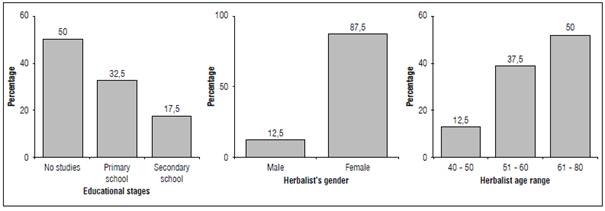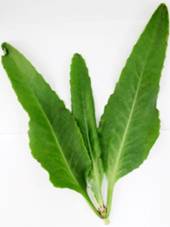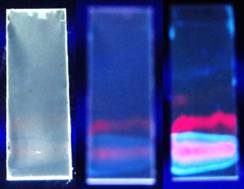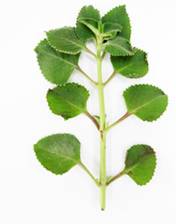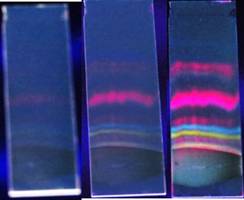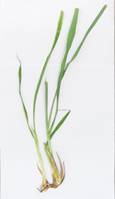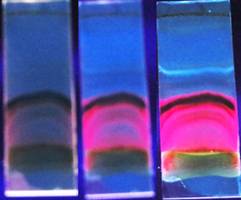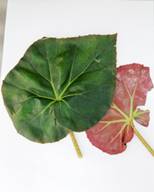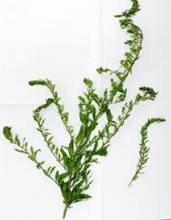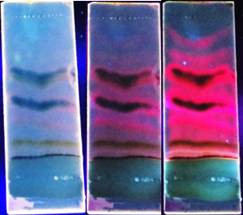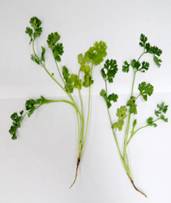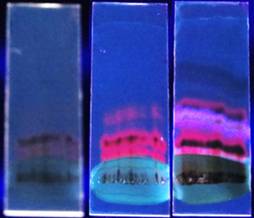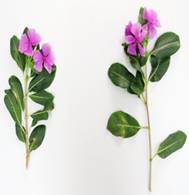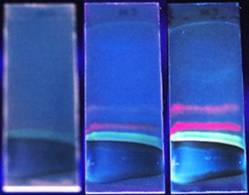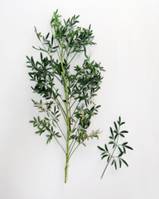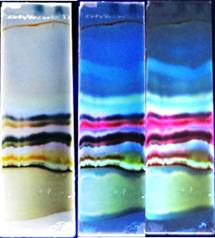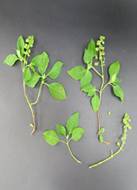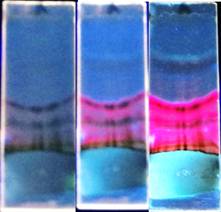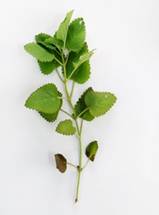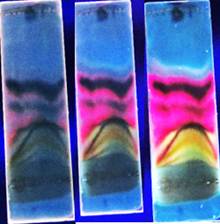INTRODUCTION
Traditional medicine is part of the culture of the people, it is an expression of intangible cultural heritage that combines different traditional knowledge and practices. Medicinal plants have been used as an alternative method to conventional medicine, and their use in developing countries has been inherited generationally. Medicinal plants are the first therapeutic strategy in 80% of developing countries and approximately 88% of the global population bases the treatment of diseases with the use of herbal medicine. The use of herbal medicine has been booming and continues to expand for the treatment of different health problems (Sánchez et al., 2020). Traditional medicine can be defined as knowledge, skills and practices based on theories, beliefs and experiences from different cultures that may or may not be explained and is used to diagnose, treat or improve physical or mental health problems and is an important component of health care in low-income countries with a prevalence between 40 and 71% (Maldonado-Miranda, 2021). In Colombia, the healing of diseases based on medicinal plants has evolved since the European conquest and is practiced mostly by rural populations. In Latin America, three distinct categories are usually used to refer to rural populations: half-bloods, indigenous and African-American peasants. In all three categories there are systems of traditional medicine built and in force in each culture, so the concept of traditional medicine is the most appropriate (Granados et al., 2005). The study of natural plant products in Colombia dates back to 1,752 with the expedition of Nicolas Baron de Joaquim, although the best work in plants was elaborated by José Celestino Mutis (González, 1980).
Traditional medicine in Colombia is divided into two branches: the magical-religious system and “curanderismo” (the art of healers). The first is based on the healing power of the supernatural. On the other hand, “curanderismo” is basically the result of combining ancient healing practices and Western medicine. “curanderismo” is practiced by midwives, herbalists, masseurs and traditional faith-healing doctors (Alvarez, 2007). A masseur acquires his empirical knowledge and not due to formal education who through massage using his hands and ointments based on mixture of certain plants and menthol treats problems of tears, sprains and strains. This treatment may or may not be accompanied by prayers. Herbalists are practitioners of traditional medicine who learn empirically those who use or prescribe medicinal plants to solve health problems (Alvarez, 2007).
Colombia has a diversity of climates and environmental conditions, which favor the growth and dispersion of different varieties and species of plants. The department of Norte de Santander has a tropical dry forest with a floristic diversity that has not been studied ethnobotanically and very little in terms of its phytochemical characterization, contrary to the existence of botanical classification reports (Carrillo-Fajardo et al., 2007). The importance of knowing the uses of medicinal plants in a region leads us to botanical knowledge, management of traditional alternative medicine and studies of phytochemical profiles that lie in possible bioactivities that can be generated from a secondary metabolite. In the absence of health centers or the lack of medical care due to the costs, plants are an alternative use for the treatment of diseases at low cost and easy preparation. The World Health Organization (WHO) recognizes the importance of the use and utilization of medicinal plants in "Primary Health Care". WHO recommends and supports their integration into national health systems and estimates that over 90% of traditional medicine recipes/remedies contain medicinal plants (Sofowora et al., 2013).
Since the origin of humanity, human beings have been concerned about their health in search of their well-being and have largely found it in nature. The knowledge to treat diseases with the use of plants is inherited in a generational way. In this way, the aim of this work is to rescue the importance of traditional knowledge in the use of plants for medicinal purposes in Norte de Santander, specifically in the Municipalities of Sardinata and Cúcuta and to report the chromatographic profile by thin layer chromatography of the medicinal plants most recommended by herbalists in this region.
MATERIALS AND METHODS
The present study was carried out in the Municipality of Sardinata (8°04´59´´ N, 72°48¨01´´ W) located 78 km from the capital of the department of Norte de Santander-Colombia, and the municipality of Cúcuta (7°55´36´´N, 72°29¨49´´W), capital of the Department. The plant material was obtained in the markets directly from the herbalists. The identification of the studied plant species has the following identification: Kalanchoe daigremontiana Raym.-Hamet (National Herbarium of Colombia, COL 36971), Origanum vulgare L. (National Herbarium of Colombia, COL-259613), Cymbopogon citratus (DC.) Stapf (National Herbarium of Colombia, COL-257113), Dysphania ambrosioides L. (National Herbarium of Colombia, COL-208783), Parietaria officinalis L. (National Herbarium of Colombia, COL-144990), Coriandrum sativum L. (National Herbarium of Colombia, COL-133893), Camellia sinensis (L.) Kuntze (National Herbarium of Colombia, COL 164027), Plantago major L. (National Herbarium of Colombia, COL-247970), Mentha spicata L. (National Herbarium of Colombia, COL-354351), Catharanthus roseus (L) G. Don (National Herbarium of Colombia COL-229746), Aloe vera (L.) Burm. f. (National Herbarium of Colombia COL 333430), Ruta graveolens L. (National Herbarium of Colombia COL-131535), Prunus domestica (Suckow) Borkh. (National Herbarium of Colombia COL-542850), Ocimum basilicum L. (National Herbarium of Colombia COL-151575), Chamaemelum nobile (L.) All. (National Herbarium of Colombia COL-29999), Melissa officinalis L. (National Herbarium of Colombia COL-293254).
Information on plants used or recommended for different ailments was collected using a face-to-face interview technique. The information was collected directly from sellers of medicinal plants in the municipalities of Sardinata and Cúcuta. The survey was designed to have a better understanding of the knowledge and use of plants for medicinal purposes in this region of the department of Norte de Santander, to obtain demographic data including age, gender, level of education and the medicinal plants of more widespread use in these municipalities. The number of respondents was 40 people who are engaged in the sale of plants in traditional medicine.
Ethanolic extract from plant samples
100 g of plant material powder-free vegetable material was mixed in ethanol (Merck, Germany). Ethanol allows the identification of polar compounds. The mixture was left 72 h in total darkness on a shaker (MAXQ 4450, Thermo ScientificTM. Marieta, United States), 35°C and 100 rpm. The extract was filtered under vacuum with filter paper (Qual. Dia. 125 mm, BOECO, Germany) using a vacuum pump (DOSIVAC, Buenos Aires, Argentina). The ethanolic extract was concentrated at reduced pressure using a rotary evaporator (IKA®RV10, Wilmington, United States) at 50 rpm, 150 mbar and 40°C. The concentrated extract was stored in amber bottles at 4°C for further analysis (Ortega-Buitrago et al., 2021).
Cromatografía de capa fina (TLC)
To determine the best separation eluent, thin layer chromatography runs of the extract were performed using different mobile phases: Ethyl hexane-acetate (95:5 v/v), ethyl-propanol acetate (9:1) and ethyl petroleum-acetate ether (7:3). All chemical reactants were from Merck, Germany the plates were run with the extract and revealed with ultraviolet light at a wavelength of 254 and 365 nm respectively to determine by fluorescence the presence of secondary metabolites (Chaves-Bedoya et al., 2022).
RESULTS
The use of medicinal plants is common in the population, although many properties, use and form of application are unknown. To acquire knowledge in the traditional management of natural resources of plant origin and its relationship with healing applications, it is important to obtain this type of information, which is part of ethnobotany and traditional folk knowledge.
Regarding the sociodemographic characteristics, the results of this study coincide with preliminary studies in which it is evident that the people who are most dedicated to traditional medicine are mostly women with low levels of education and over 50 years (Chali et al., 2021). Figure 1 shows information on the age range, sex and education level of the respondents. The information obtained clearly indicates that the elderly plays an important role in traditional medicine due to the empirical knowledge acquired in the use and preparation of different plants in the treatment of ailments and diseases. This knowledge is transmitted generationally preserving it and in turn maintaining a mode of family sustenance. However, this empirical knowledge must be verified in order to contribute to the improvement and safety in the use of phytotherapics in communities (Escalona et al., 2015).
In Mesoamerica, traditional medicine is also used mainly by rural and indigenous communities (Geck et al., 2020). In Colombia, traditional plant-based remedies are considered an integral part of culture and the country has approximately 10% of the world’s biodiversity with approximately 50,000 plant species (Gómez-Estrada et al., 2011). In the municipalities of Sardinata and Cúcuta in Norte de Santander the plants most recommended by herbalists or the most sought after by consumers areKalanchoe daigremontiana, Origanum vulgare, Cymbopogon citratus, Dysphania ambrosioides, Begonia erythrophylla, Parietaria officinalis, Coriandrum sativum, Camellia sinensis, Plantago major, Mentha spicata, Catharanthus roseus, Aloe vera, Ruta graveolens, Prunus domestica, Ocimum basilicum, Chamaemelum nobile, and Melissa officinalis. These plants are consumed mainly in infusion. The most recommended plant for consumption is Kalanchoe (Kalanchoe daigremontiana) popularly known as a bad mother or mother of thousands. Kalanchoe species are succulents with anti-inflammatory, antioxidant, and analgesic properties, as well as cytotoxic activity (Stefanowicz-Hajduk et al., 2022). Kalanchoe species are well-known medicinal plants used in traditional medicine (Stefanowicz-Hajduk et al., 2020).
According to herbalists, the health ailments for which people in Sardinata and Cúcuta seek help from folk medicine are stomach cramps, cancer, ear pain, cough, flu, fever, kidney problems, gastritis, skin spots, nausea, headache, wound healing, anxiety or nerves, muscle aches, anemia, uterine problems, liver problems, and eye infection. When reviewing the existing literature it is found that the above are similar ailments for which people from other countries or continents seek help from herbalists (Oyebode et al., 2016; Chali et al., 2021).
Thin layer chromatography of ethanolic extracts of medicinal plants
The medicinal plants recommended by herbalists were used to obtain the ethanolic extracts in order to determine the group of secondary metabolites present in each plant material. The medicinal or healing properties of a plant depend on its secondary metabolites (Twaij and Hasan, 2022). Ethanol has the ability to extract compounds with a wide range of polarities, as well as being less expensive and toxic than other organic solvents. Recognition of secondary metabolites was performed based on reported qualitative tests (Martínez et al., 2008).
Once the extract of each plant was concentrated, the chromatographic profile was performed by thin layer chromatography. The observation under UV light at different wavelengths allowed to show different colorations. For example, a fluorescent yellow and light blue color indicate the presence of flavones, isoflavones, certain coumarins and alkaloids, a red and fuchsia color are indicative of the presence of sesquiterpenes and terpenoids, etc. (Reich and Schibli, 2006). In Table 1, TLC results are indicated for each medicinal plant recommended in Sardinata and Cúcuta.
Table 1 Qualitative analysis by TLC of ethanolic extracts of medicinal plants.
The results of the analysis by TLC show that in families Agavaceae, Lamiaceae, Poaceae, Begoniaceae, Urticaceae, Theaceae, Plantaginaceae, Apocynaceae and Rutaceae there is presence of flavones, flavonones, isoflavones, coumarins and alkaloids, sesquiterpenes and terpenoids, in the species Chlorophytum comosum, Origanum vulgare, Cymbopogon citratus, Begonia erythrophylla, Parietaria officinalis, Camellia sinensis, Plantago major, Mentha spicata, Catharanthus roseus, Ocimum basilicum and Ruta graveolens. The presence of sesquiterpenes and terpenoids was observed in families Amaranthaceae, Apiaceae, Rosaceae and Asteraceae in the species Dysphania ambrosioides, Coriandrum sativum, Chamaemelum nobile and Prunus domestica.
DISCUSSION
The results of the qualitative chemical composition analysis of the medicinal plants studied revealed an abundance of flavoins, flavonoids, isoflavones, coumarins and alkaloids which correspond to the main groups of secondary metabolites with medicinal effects (Twaij and Hasan, 2022) corroborating their medicinal and traditional applications in the region. The review of the existing scientific literature on plants used in this research, demonstrates biological and therapeutic properties. These properties include anti-inflammatory, antioxidant, antimicrobial, anticancer and anxiolytic effects, among others, which are attributable to the presence of the metabolites detected (Supratman et al., 2001; Leyva-López et al., 2016; Jafari et al., 2022; Petrisor et al., 2022). In example, terpenes, also known as isoprenoids or terpenoids, constitute the most diverse group of natural compounds. Terpenes as natural compounds have various medical properties among which are anti-inflammatory, antioxidant, anti-carcinogenic, antiseptic, astringent, digestive, diuretic activities among others (Cox-Georgian et al., 2019). Finally, it is known that alkaloids play a fundamental role in human medicine, as well as in the natural defense of an organism. Therapeutically, alkaloids are known as anesthetics, cardioprotective, and anti-inflammatory (Heinrich et al., 2021).
It has been described that flavonoids are the chemical compounds of greater presence in the medicinal plants studied. These phytochemicals are secondary metabolites with potential applications in medicinal chemistry. The different medicinal benefits of flavonoids include anti-cancer, anti-inflammatory, antioxidant, anti-viral, anti-aging, anti-diabetic and heart-healthy activity (Wang et al., 2018). However, research is required to determine the biological target and activity of these compounds. The modes of action of flavonoids as therapeutic agents have recently been described (Ullah et al., 2020).
Understanding knowledge of medicinal plants provides valuable insight into the cultural significance of plant resources, i.e., which species are recognized as effective and valued in a community (de Albuquerque et al., 2007). In addition, this knowledge can provide information on the various ways in which populations use medicinal plants to treat different ailments and maintain their well-being (Pardo-De-Santayana et al., 2005). Studies carried out in the region of Sardinata and Cúcuta, in Norte de Santander, have demonstrated the wealth of traditional knowledge on the use of medicinal plants, reflecting the close relationship between local communities and their natural resources. These investigations allow a synergistic learning regarding the idiosyncrasy of the population of a region and the use of plants and other natural resources, exalting the importance of these in the life of a community for their diverse therapeutic and cultural uses (González et al., 2010).
Despite the therapeutic benefits of medicinal plants in the region, it is necessary to approach self-medication with caution, since it can lead to poisoning and even death due to ignorance of the adverse effects, contraindications and adequate doses of these plants (Bennett and Brown, 2000). Medicinal plants contain active ingredients, substances with pharmacotherapeutic properties that can target and alleviate various diseases or ailments. While these substances can benefit the body, excessive consumption can lead to adverse effects. Traditional medicine users who prepare their remedies without proper guidance from herbalists may inadvertently cause harm to their bodies due to the complex phytochemical composition of the plants (Mensah et al., 2019). Self-medication can aggravate health problems rather than improve them, so it is essential to promote education and awareness about the correct use of medicinal plants in local communities (Alonso-Castro et al., 2017).
For example, although Kalanchoe daigremontiana, the medicinal plant most recommended by herbalists in Sardinata and Cúcuta, has been shown to possess antioxidant properties and anticancer activity (Stefanowicz-Hajduk et al., 2022), It is crucial to consider the proper dosage. Excessive consumption of this plant could cause poisoning or unwanted side effects (Posadzki et al., 2013). Therefore, it is essential to foster collaboration between health professionals, herbalists and community members to ensure safe and effective use of medicinal plants. This could include training programs, workshops and educational materials that promote knowledge about the properties, dosages and contraindications of medicinal plants used in the region.
The study of the traditional practices of using medicinal plants also contributes to the conservation of this ancestral knowledge, which may be endangered due to globalization and biodiversity loss. Likewise, the documentation and analysis of this knowledge can serve as a basis for future scientific research, which seeks to validate the effectiveness of medicinal plants in the prevention and treatment of diseases, as well as the discovery of new bioactive compounds (Cámara-Leret et al., 2014).
By deepening traditional knowledge on the use of medicinal plants it is possible not only to strengthen the relationship between communities and their natural environment, but also to promote the sustainable use and conservation of biodiversity in these areas (Molares and Ladio, 2014). Ethnobotanical studies can also contribute to the generation of public policies aimed at protecting and promoting traditional medicine, as well as recognizing and valuing the role of ancestral knowledge in the health care of local communities (Bussmann et al., 2007).
CONCLUSION
Traditional medicine represents a crucial aspect of ancestral knowledge within communities, utilizing a variety of plant species for treating diseases and ailments. This enduring knowledge, passed down through generations and rooted in experience, provides relief for health issues, particularly for those with limited resources who cannot afford costly medications. In the municipalities of Sardinata and Cúcuta, women over the age of 60 primarily engage in the sale and recommendation of medicinal plants, which encompass 17 botanical species across 14 families. Medicinal plants maintain cultural significance as they are perceived as natural, affordable remedies.
TLC analyses have qualitatively identified the presence of diverse secondary metabolites, including flavones, flavonones, isoflavones, coumarins, alkaloids, sesquiterpenes, and terpenoids. These metabolites are essential for human health and form the structural basis for numerous pharmaceutical drugs. In addition to preserving and sustaining communities' ancestral knowledge, this type of research serves as a strategic approach for new drug discovery by selecting candidates containing metabolites known for their therapeutic properties. Lately, there has been a renewed interest in bioactive natural products, fueled by traditional medicines and their potential for drug discovery.














